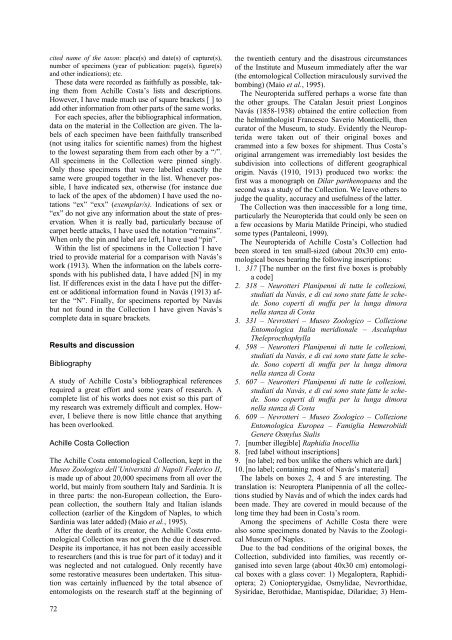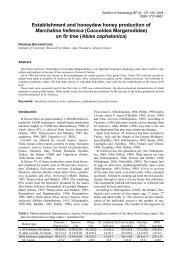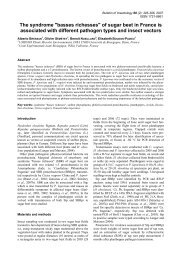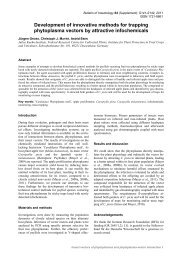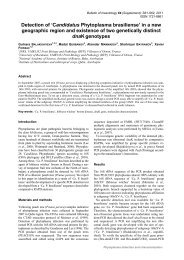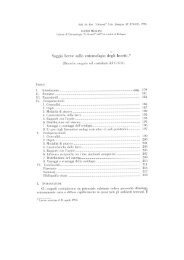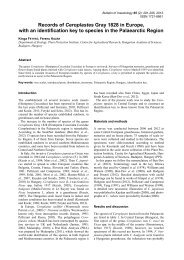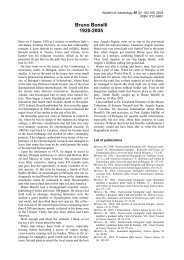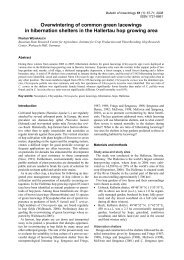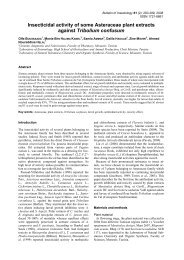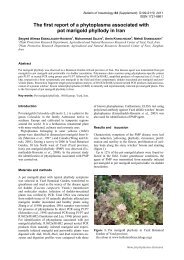Interpretation of Achille Costa's data on Neuropterida - Bulletin of ...
Interpretation of Achille Costa's data on Neuropterida - Bulletin of ...
Interpretation of Achille Costa's data on Neuropterida - Bulletin of ...
Create successful ePaper yourself
Turn your PDF publications into a flip-book with our unique Google optimized e-Paper software.
cited name <str<strong>on</strong>g>of</str<strong>on</strong>g> the tax<strong>on</strong>: place(s) and date(s) <str<strong>on</strong>g>of</str<strong>on</strong>g> capture(s),<br />
number <str<strong>on</strong>g>of</str<strong>on</strong>g> specimens (year <str<strong>on</strong>g>of</str<strong>on</strong>g> publicati<strong>on</strong>: page(s), figure(s)<br />
and other indicati<strong>on</strong>s); etc.<br />
These <str<strong>on</strong>g>data</str<strong>on</strong>g> were recorded as faithfully as possible, taking<br />
them from <str<strong>on</strong>g>Achille</str<strong>on</strong>g> Costa’s lists and descripti<strong>on</strong>s.<br />
However, I have made much use <str<strong>on</strong>g>of</str<strong>on</strong>g> square brackets [ ] to<br />
add other informati<strong>on</strong> from other parts <str<strong>on</strong>g>of</str<strong>on</strong>g> the same works.<br />
For each species, after the bibliographical informati<strong>on</strong>,<br />
<str<strong>on</strong>g>data</str<strong>on</strong>g> <strong>on</strong> the material in the Collecti<strong>on</strong> are given. The labels<br />
<str<strong>on</strong>g>of</str<strong>on</strong>g> each specimen have been faithfully transcribed<br />
(not using italics for scientific names) from the highest<br />
to the lowest separating them from each other by a “/”.<br />
All specimens in the Collecti<strong>on</strong> were pinned singly.<br />
Only those specimens that were labelled exactly the<br />
same were grouped together in the list. Whenever possible,<br />
I have indicated sex, otherwise (for instance due<br />
to lack <str<strong>on</strong>g>of</str<strong>on</strong>g> the apex <str<strong>on</strong>g>of</str<strong>on</strong>g> the abdomen) I have used the notati<strong>on</strong>s<br />
“ex” “exx” (exemplar/s). Indicati<strong>on</strong>s <str<strong>on</strong>g>of</str<strong>on</strong>g> sex or<br />
“ex” do not give any informati<strong>on</strong> about the state <str<strong>on</strong>g>of</str<strong>on</strong>g> preservati<strong>on</strong>.<br />
When it is really bad, particularly because <str<strong>on</strong>g>of</str<strong>on</strong>g><br />
carpet beetle attacks, I have used the notati<strong>on</strong> “remains”.<br />
When <strong>on</strong>ly the pin and label are left, I have used “pin”.<br />
Within the list <str<strong>on</strong>g>of</str<strong>on</strong>g> specimens in the Collecti<strong>on</strong> I have<br />
tried to provide material for a comparis<strong>on</strong> with Navás’s<br />
work (1913). When the informati<strong>on</strong> <strong>on</strong> the labels corresp<strong>on</strong>ds<br />
with his published <str<strong>on</strong>g>data</str<strong>on</strong>g>, I have added [N] in my<br />
list. If differences exist in the <str<strong>on</strong>g>data</str<strong>on</strong>g> I have put the different<br />
or additi<strong>on</strong>al informati<strong>on</strong> found in Navás (1913) after<br />
the “N”. Finally, for specimens reported by Navás<br />
but not found in the Collecti<strong>on</strong> I have given Navás’s<br />
complete <str<strong>on</strong>g>data</str<strong>on</strong>g> in square brackets.<br />
Results and discussi<strong>on</strong><br />
Bibliography<br />
A study <str<strong>on</strong>g>of</str<strong>on</strong>g> <str<strong>on</strong>g>Achille</str<strong>on</strong>g> Costa’s bibliographical references<br />
required a great effort and some years <str<strong>on</strong>g>of</str<strong>on</strong>g> research. A<br />
complete list <str<strong>on</strong>g>of</str<strong>on</strong>g> his works does not exist so this part <str<strong>on</strong>g>of</str<strong>on</strong>g><br />
my research was extremely difficult and complex. However,<br />
I believe there is now little chance that anything<br />
has been overlooked.<br />
<str<strong>on</strong>g>Achille</str<strong>on</strong>g> Costa Collecti<strong>on</strong><br />
The <str<strong>on</strong>g>Achille</str<strong>on</strong>g> Costa entomological Collecti<strong>on</strong>, kept in the<br />
Museo Zoologico dell’Università di Napoli Federico II,<br />
is made up <str<strong>on</strong>g>of</str<strong>on</strong>g> about 20,000 specimens from all over the<br />
world, but mainly from southern Italy and Sardinia. It is<br />
in three parts: the n<strong>on</strong>-European collecti<strong>on</strong>, the European<br />
collecti<strong>on</strong>, the southern Italy and Italian islands<br />
collecti<strong>on</strong> (earlier <str<strong>on</strong>g>of</str<strong>on</strong>g> the Kingdom <str<strong>on</strong>g>of</str<strong>on</strong>g> Naples, to which<br />
Sardinia was later added) (Maio et al., 1995).<br />
After the death <str<strong>on</strong>g>of</str<strong>on</strong>g> its creator, the <str<strong>on</strong>g>Achille</str<strong>on</strong>g> Costa entomological<br />
Collecti<strong>on</strong> was not given the due it deserved.<br />
Despite its importance, it has not been easily accessible<br />
to researchers (and this is true for part <str<strong>on</strong>g>of</str<strong>on</strong>g> it today) and it<br />
was neglected and not catalogued. Only recently have<br />
some restorative measures been undertaken. This situati<strong>on</strong><br />
was certainly influenced by the total absence <str<strong>on</strong>g>of</str<strong>on</strong>g><br />
entomologists <strong>on</strong> the research staff at the beginning <str<strong>on</strong>g>of</str<strong>on</strong>g><br />
72<br />
the twentieth century and the disastrous circumstances<br />
<str<strong>on</strong>g>of</str<strong>on</strong>g> the Institute and Museum immediately after the war<br />
(the entomological Collecti<strong>on</strong> miraculously survived the<br />
bombing) (Maio et al., 1995).<br />
The <strong>Neuropterida</strong> suffered perhaps a worse fate than<br />
the other groups. The Catalan Jesuit priest L<strong>on</strong>ginos<br />
Navás (1858-1938) obtained the entire collecti<strong>on</strong> from<br />
the helminthologist Francesco Saverio M<strong>on</strong>ticelli, then<br />
curator <str<strong>on</strong>g>of</str<strong>on</strong>g> the Museum, to study. Evidently the <strong>Neuropterida</strong><br />
were taken out <str<strong>on</strong>g>of</str<strong>on</strong>g> their original boxes and<br />
crammed into a few boxes for shipment. Thus Costa’s<br />
original arrangement was irremediably lost besides the<br />
subdivisi<strong>on</strong> into collecti<strong>on</strong>s <str<strong>on</strong>g>of</str<strong>on</strong>g> different geographical<br />
origin. Navás (1910, 1913) produced two works: the<br />
first was a m<strong>on</strong>ograph <strong>on</strong> Dilar parthenopaeus and the<br />
sec<strong>on</strong>d was a study <str<strong>on</strong>g>of</str<strong>on</strong>g> the Collecti<strong>on</strong>. We leave others to<br />
judge the quality, accuracy and usefulness <str<strong>on</strong>g>of</str<strong>on</strong>g> the latter.<br />
The Collecti<strong>on</strong> was then inaccessible for a l<strong>on</strong>g time,<br />
particularly the <strong>Neuropterida</strong> that could <strong>on</strong>ly be seen <strong>on</strong><br />
a few occasi<strong>on</strong>s by Maria Matilde Principi, who studied<br />
some types (Pantale<strong>on</strong>i, 1999).<br />
The <strong>Neuropterida</strong> <str<strong>on</strong>g>of</str<strong>on</strong>g> <str<strong>on</strong>g>Achille</str<strong>on</strong>g> Costa’s Collecti<strong>on</strong> had<br />
been stored in ten small-sized (about 20x30 cm) entomological<br />
boxes bearing the following inscripti<strong>on</strong>s:<br />
1. 317 [The number <strong>on</strong> the first five boxes is probably<br />
a code]<br />
2. 318 – Neurotteri Planipenni di tutte le collezi<strong>on</strong>i,<br />
studiati da Navás, e di cui s<strong>on</strong>o state fatte le schede.<br />
S<strong>on</strong>o coperti di muffa per la lunga dimora<br />
nella stanza di Costa<br />
3. 331 – Nevrotteri – Museo Zoologico – Collezi<strong>on</strong>e<br />
Entomologica Italia meridi<strong>on</strong>ale – Ascalaphus<br />
Theleprocthophylla<br />
4. 598 – Neurotteri Planipenni di tutte le collezi<strong>on</strong>i,<br />
studiati da Navás, e di cui s<strong>on</strong>o state fatte le schede.<br />
S<strong>on</strong>o coperti di muffa per la lunga dimora<br />
nella stanza di Costa<br />
5. 607 – Neurotteri Planipenni di tutte le collezi<strong>on</strong>i,<br />
studiati da Navás, e di cui s<strong>on</strong>o state fatte le schede.<br />
S<strong>on</strong>o coperti di muffa per la lunga dimora<br />
nella stanza di Costa<br />
6. 609 – Nevrotteri – Museo Zoologico – Collezi<strong>on</strong>e<br />
Entomologica Europea – Famiglia Hemerobiidi<br />
Genere Osmylus Sialis<br />
7. [number illegible] Raphidia Inocellia<br />
8. [red label without inscripti<strong>on</strong>s]<br />
9. [no label; red box unlike the others which are dark]<br />
10. [no label; c<strong>on</strong>taining most <str<strong>on</strong>g>of</str<strong>on</strong>g> Navás’s material]<br />
The labels <strong>on</strong> boxes 2, 4 and 5 are interesting. The<br />
translati<strong>on</strong> is: Neuroptera Planipennia <str<strong>on</strong>g>of</str<strong>on</strong>g> all the collecti<strong>on</strong>s<br />
studied by Navás and <str<strong>on</strong>g>of</str<strong>on</strong>g> which the index cards had<br />
been made. They are covered in mould because <str<strong>on</strong>g>of</str<strong>on</strong>g> the<br />
l<strong>on</strong>g time they had been in Costa’s room.<br />
Am<strong>on</strong>g the specimens <str<strong>on</strong>g>of</str<strong>on</strong>g> <str<strong>on</strong>g>Achille</str<strong>on</strong>g> Costa there were<br />
also some specimens d<strong>on</strong>ated by Navás to the Zoological<br />
Museum <str<strong>on</strong>g>of</str<strong>on</strong>g> Naples.<br />
Due to the bad c<strong>on</strong>diti<strong>on</strong>s <str<strong>on</strong>g>of</str<strong>on</strong>g> the original boxes, the<br />
Collecti<strong>on</strong>, subdivided into families, was recently organised<br />
into seven large (about 40x30 cm) entomological<br />
boxes with a glass cover: 1) Megaloptera, Raphidioptera;<br />
2) C<strong>on</strong>iopterygidae, Osmylidae, Nevrorthidae,<br />
Sysiridae, Berothidae, Mantispidae, Dilaridae; 3) Hem-


